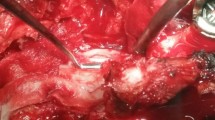Abstract
Purpose
Postoperative CSF leak is a known complication of spinal surgery especially after surgery for neural tube defects (NTD). The problem can metamorphose into a severe infection. This article hopes to shed some light on the management of these problems and suggests precautions so as to reduce their occurrence.
Materials and methods
A retrospective analysis of 102 children, between the ages of 1 day and 12 years, operated for various spinal pathologies, over the past 2.5 years by the same surgeon (CB) was done. The various methods of dural closure were noted. The methods of management of postoperative CSF leaks were analysed, and the patients were followed till discharge.
Results
The incidence of CSF leak was found to be 12.7 %. The methods of management included lumbar drain only (n = 7), lumbar drain with re-exploration (n = 3), lumbar drain followed by lumboperitoneal shunt (n = 2) and only lumboperitoneal shunt (n = 1). The use of fibrin glue did not seem to significantly prevent the incidence of CSF leak in cases.
Conclusions
Primary and meticulous dural closure is sine qua non in preventing postoperative CSF leak. A lumbar drain is a convenient and economical method of managing the problem initially failing which more invasive methods like re-exploration may be employed.






Similar content being viewed by others
References
Beier AD, Barrett RJ, Soo TM (2010) Aneurysm clips for durotomy repair: technical note. Neurosurgery 66(3 Suppl Operative):E124–E125, discussion E125
Boop FA, Chadduck (1991) Silastic duraplasty in pediatric patients. Neurosurgery 29(5):785–787, discussion 788
Chern JJ, Tubbs RS, Patel AJ, Gordon AS, Bandt SK, Smyth MD, Jea A, Oakes WJ (2011) Preventing cerebrospinal fluid leak following transection of a tight filum terminale. J Neurosurg Paediatrics 8(1):35–38
Della Puppa A, Rossetto M, Scienza R (2010) Use of a new absorbable sealing film for preventing postoperative cerebrospinal fluid leaks: remarks on a new approach. Br J Neurosurgery 24(5):609–611
Goel A (1997) A shunting procedure employing cannulation of the lumbar theca through the meningocele sac. Br J Neurosurgery 11(5):429–430
Ito K, Yanagawa T, Horiuchi T, Sakai K, Hongo K (2010) Application of a polyethylene glycol hydrogel sealant system to prevent CSF leakage for lumbar intradural surgery: technical case report. No Shinkei Geka 38(12):1127–1131
Kaufman BA, Matthews AE, Zwienenberg-Lee M, Lew SM (2010) Spinal dural closure with non-penetrating titanium clips in pediatric neurosurgery. J Neurosurg Pediatrics 6(4):359–363
Levi B, Sugg KB, Lien SC, Kasten SJ, Muraszko KM, Maher CO, Buchman SR (2011) Outcomes of tethered cord repair with a layered soft tissue closure. Ann Plast Surg. Sep 14. [Epub ahead of print]
Liu V, Gillis C, Cochrane D, Singhala A, Steinbok P (2014) CSF complications following intradural spinal surgeries in children. Childs Nerv Syst 30:299–305
Nakamura H, Matsuyama Y, Yoshihara H, Sakai Y, Katayama Y, Nakashima S, Takamatsu J, Ishiguro N (2005) The effect of autologous fibrin tissue adhesive on postoperative cerebrospinal fluid leak in spinal cord surgery: a randomized controlled trial. Spine (Phila Pa 1976) 30(13):E347–E351
Ogiwara H, Morota N, Joko M (2012) Duration of horizontal decubitus after section of a tight filum terminale as a means to prevent cerebrospinal fluid leakage. Surg Neurol Int 3:113
Osbun JW, Ellenbogen RG, Chesnut RM, Chin LS, Connolly PJ, Cosgrove GR, Delashaw JB Jr, Golfinos JG, Greenlee JD, Haines SJ, Jallo J, Muizelaar JP, Nanda A, Shaffrey M, Shah MV, Tew JM Jr, van Loveren HR, Weinand ME, White JA, Wilberger JE (2011)A multicenter, single-blind, prospective randomized trial to evaluate the safety of a polyethylene glycol hydrogel (duraseal dural sealant system) as a dural sealant in cranial surgery, World Neurosurg. Dec 10. [Epub ahead of print]
Ostling LR, Bierbrauer KS, Kuntz C (2012) Outcome, reoperation, and complications in 99 consecutive children operated for tight or fatty filum. World Neurosurg 77(1):187–191
Parízek J, Nĕmecková J, Mĕricka P, Eliás P, Sercl M, Lichý J (1990) External lumbar cerebrospinal fluid drainage with controlled flow—its use in pediatric neurosurgery. Cas Lek Cesk 129(36):1138–1140
Rotenberg BW, Marchie A, Cusimano MD (2004) Skin sealants: an effective option for closing cerebrospinal fluid leakage. Can J Surg 47(6):466–468
Vällfors B, Hansson HA, Svensson (1981) Absorbable or nonabsorbable suture materials for closure of the dura mater? J Neurosurgery 9(4):407–413
Verheggen R, Schulte-Baumann WJ, Hahm G, Lang J, Freudenthaler S, Schaake T, Markakis E (1997) A new technique of dural closure—experience with a vicryl mesh. Acta Neurochir (Wien) 139(11):1074–1079
Wang B, Hong Y, Yi B, Yu X, Wang C (2002) Operative complications in tethered cord syndrome and their management. Zhonghua Wai Ke Za Zhi 40(4):284–286
Author information
Authors and Affiliations
Corresponding author
Additional information
This article was presented in part at the annual meeting of the International Society for Pediatric Neurosurgery held at Sydney, Australia in 2012.
Rights and permissions
About this article
Cite this article
Balasubramaniam, C., Rao, S.M. & Subramaniam, K. Management of CSF leak following spinal surgery. Childs Nerv Syst 30, 1543–1547 (2014). https://doi.org/10.1007/s00381-014-2496-2
Received:
Accepted:
Published:
Issue Date:
DOI: https://doi.org/10.1007/s00381-014-2496-2




